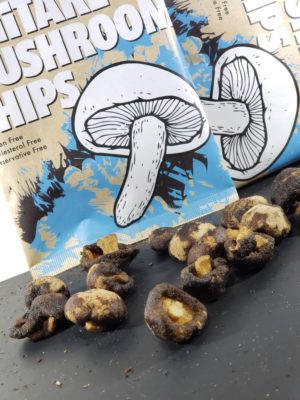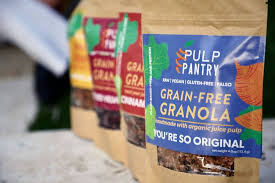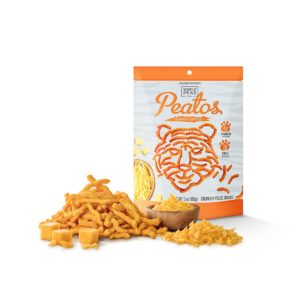Produce-based snack choices broadened by new approaches
By Scott Stuntz | Contributing Writer
Change just one detail about a snack food and a familiar, some would even say boring, item becomes something completely different.
Beef jerky is a well-loved product that has been around in some form for hundreds of years, but mushroom jerky has only come onto the scene recently. Giorgio Fresh has grown mushrooms since 1920 and recently launched its Savory Wild line of portabella jerky, joining brands like Pan’s Mushroom Jerky.
Companies across the snacking category are creating new twists on familiar products or are opening new options by investing in packaging research. Still others are using ingredients that are byproducts of food industries to create entirely new products.
Start with the outside
Mushrooms are finding their way into jerky, but that is not the only form they are being put into. Mushrooms are also being prepared in other ways to create new snack items, including chips. MudLrk shitake mushroom chips hit stores this year in a variety of flavors.
 While there are crunchy mushrooms in other food products, mostly dried mushrooms in noodle meals, there really hadn’t been a crunchy mushroom-based consumer packaged good (CPG) aimed at the U.S. market.
While there are crunchy mushrooms in other food products, mostly dried mushrooms in noodle meals, there really hadn’t been a crunchy mushroom-based consumer packaged good (CPG) aimed at the U.S. market.
MudLrk’s founder, Trace Ostergren, previously developed another CPG, a line of banana coconut chips marketed to airlines. While those chips and the new MudLrk chips are quite different in terms of flavor they have at least one thing in common — their packaging.
“I didn’t have a food product at the time,” Ostergren said of developing the first chip product four years ago, called Fly Green Snacks. “I just started working on the packaging because I knew I didn’t want to use flexible plastic-type, petroleum packaging I wanted some that was rather eco-friendly, either partially or 100 percent compostable and also looked like it was as well.”
Once he was able to create a multilayer package with a brown paper exterior that fit his requirements. he went looking for a food product. After creating Fly Green, Ostergren began looking for a product to be sold to consumers and began to look at mushrooms.
“Everything I found led me back to East Asia, where the shiitakes are native,” he said
Ostergren had an advantage when it came to looking for products in that part of the world. He went to both high school and college in China, visits there at least once a year and speaks Mandarin.
“So it was kind of easy for me to dive into the produce industry there in regards to mushrooms and identify farmers, and checking out how they are cultivated,” he said.
The chips’ only ingredients are shiitake mushrooms, palm oil and flavoring. The mushrooms are vacuum fried in the palm oil with a small amount of sugar, which adds a touch of sweetness but also helps the mushrooms retain their structure under the frying process.
Once he had the food product figured out, he plugged it into the packaging process he already had established for Fly Green. Ostergren said he has gotten interest at shows like United Fresh. People like the product as well as the packaging, he said, especially its eco-conscious and compostable nature.
Waste not, want not
Pulp Pantry founder Kaitlin Mogentale started her career in environmental studies. While working at a nonprofit in the Las Angeles area, she became interested in the concept of food justice, which is a community’s right to “grow, sell and eat healthy food.”
 She said that even though the city is surrounded by farms, there are neighborhoods that don’t have access to fruits and vegetables. Combining her quest to supply communities with healthy food and to encourage sustainability, Mogentale developed the idea for Pulp Pantry.
She said that even though the city is surrounded by farms, there are neighborhoods that don’t have access to fruits and vegetables. Combining her quest to supply communities with healthy food and to encourage sustainability, Mogentale developed the idea for Pulp Pantry.
“I found out about the pulp being wasted and the scale of the problem, and seeing that for every pound of juice produced there could be as much as four pounds of pulp going to waste,” Mogentale said. “That’s where I thought these two things connect and there is a really beautiful way to bring more affordable and nutritious food access by using a byproduct that people have been neglecting.”
The company uses the pulp from juice operations to create nutritious, baked snacks. She said some juice operations, because of their size and location, had to pay to dispose of their pulp in a landfill sometimes to the tune of a million dollars a year. Some other juice makers are able to sell their pulp as cattle feed, but Mogentale said they often receive only 3 cents a pound for it.
By baking the pulp, the product is shelf stable and can be distributed more easily than fresh fruits and vegetables. Pulp Pantry creates snacks out of ingredients such as carrot, beet and apple pulp.
Aside from providing nutritionally balanced snacks to underserved areas, Pulp Pantry’s products also unlock the nutrients in the pulp that would either rot in a landfill or feed cattle otherwise.
“For us fiber is kind of the biggest piece of what we’re doing. Three percent of Americans get their daily servings of fiber and on a larger scale around 13 percent of Americans are eating their fruits and vegetables every day,” Mogentale said. “So zoning in on fiber as the resource that could make a difference in people’s health, pulp can be rich resource for that.”
She said even if people want to eat more fruits and vegetables sometimes they don’t have the time, access or ways to prepare them, so making eating fruits and vegetables more convenient is Pulp Pantry’s “sweet spot.”
Healthier junk food
According to the 2018 State of the Snack Food Industry report put out by consumer insight firm IRI, of the four categories of snack food (permissible indulgence, true indulgence, treats and wellness) only one saw its sales drop — wellness.
 Nick Desai, CEO of Snack It Forward-World Peas Brand, which makes Peatos, said he’s seen separate numbers showing that last year traditional snacks like Cheetos and Doritos grew 2 percent while wellness snacks were down for the first time.
Nick Desai, CEO of Snack It Forward-World Peas Brand, which makes Peatos, said he’s seen separate numbers showing that last year traditional snacks like Cheetos and Doritos grew 2 percent while wellness snacks were down for the first time.
In the future, he said the fastest growing category will be “alternative” snacks, like Peatos. Desai defines alternative snacks such as Peatos as those that are made from alternative ingredients but don’t prioritize health claims as their selling point.
“I think you’ll see more and more consumers not willing to make a sacrifice. It won’t be the ‘either or’ anymore,” Desai said. “It won’t be that ‘either I want to eat healthy today or satisfy my taste buds.’ It’s going to be ‘I want to do both.’”
Desai said that the traditional Cheetos have sales of around $1.7 billion while the number two snack in the category only comes in with $60 million in sales. That told him it was high time to “shake things up.”
Having grown up on American-style crunchy, salty snacks, Desai sought out the same type of taste on trips to India while growing up. During those visits, he saw a lot of pulse-based snacks. That gave him idea for a puffed snack that uses peas and lentils instead of corn.
However, Peatos was not intended to be a health food, but something closer to a better-for-you junk food, something that would appeal to a Walmart shopper. That meant the pea taste needed to be undetectable.
“It’s got to look, act and feel a lot like a piece of junk food,” he said.
That is not to say that Peatos lacks any nutritional advantages over traditional snacks. Compared to Cheetos, Peatos have 2 grams of additional protein and 30 fewer calories per serving. Also, though it wasn’t a goal of the company, one of Peatos’ flavors, fiery hot, is vegan.
Desai said those in the vegan community had been searching for vegan version of a hot Cheeto and were ecstatic when they discovered that Peatos came out with an option.
Peatos launched nationally in Kroger stores in May of this year.







